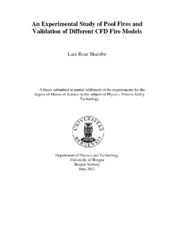| dc.description.abstract | Computer programs developed to predict a possible fire scenario is today an important tool when working with fire safety. In this context different Computational Fluid Dynamics models, so called CFD models, where the domain of interest is divided into thousands of small control volumes, is widely used. An important task when developing fire models are validation against experiments. This involves recreating the experimental setup in the CFD models and comparisons of the results from the simulation with the experimental results. Initially, in the work with this thesis, literature from previous pool fire experiments was collected and organized through a literature search. Even if there are a lot experimental data available for validation, it was decided to perform additional pool fire experiments in order to compare results with the CFD models FLACS (FLame Accelerator Simulator) and FDS (Fire Dynamic Simulator). From the literature search amongst existing experiments it was noticed that there were little experimental data available on pool fires with equipment other than tanks above the pool. Several 0.5m x 0.5m heptane pool fire experiments with pipes obstructing above the fire were studied in the fire laboratory at SHUC(Stord/Haugesund University College). Different obstruction areas in different heights above the obstruction were tested in order to verify what effect it had on the fire. A cone calorimeter analysed the smoke from the fire. Additionally, temperature, radiative heat flux and mass loss rate were measured. These experiments showed that when a pipe obstruction is located close to the pool fire it has a decreasing effect on the heat release rate and thermal radiation from the fire. In order to verify if this also was the case with increased fire diameter, outdoor pool fire experiments with increased area were performed. Due to wind conditions during these experiments the results were not valid for use in verification. However, the outdoor experiments showed that the pipe effect can be neglected for windy conditions. In the validation process of the CFD models FLACS and FDS, two additional experiments performed by Steckler et al. (1982) and Gutiérrez-Montez et al. (2009) are studied. Following parameters are validated against experiments; heat release rate, radiative heat flux, temperatures and velocity in flame, hot smoke gases and air. Simulations revealed that temperature and velocity in the hot smoke layer is close to experimental results for both FLACS and FDS. In FDS, radiative heat flux is well predicted when the fire is defined with mass loss rate or heat release rate. When using the liquid fuel model, where FDS calculated the evaporation rate, results are very grid dependent. This is also stated in the FDS User Guide. It seems that both simulations programs over predict the flame temperatures. Since small grid resolution is necessary in the flame region, further reduction in grid size probably would have improved these results. The pipe effects observed in the experimental work are not fully reproduced in the simulations. Some reductions in HRR and thermal radiation as well as narrower flame are observed in FDS using the liquid fuel model. | en_US |
